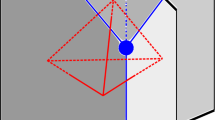Abstract
A comparative discussion of SU(2) and SU(1,1) spinor algebras is presented. Spin coefficients are introduced in both formalisms. Although particular flat-space spin and coordinate frame is used, the fundamental relations are given in a covariant notation such that the method can easily be adapted to spinor fields in curved three-spaces also. The SU(1,1) spin coefficients are used to obtain the stationary axisymmetric gravitational equations in a form in which all the field quantities appear as spin coefficients of a flat hyperbolic three-space.
Резюме
В статье излагается сравнительный анализ спинорной алгебры. Спиновые коэффициенты вводятся в формализм SU(2) и, соответственно, SU(1,1). Поскольку в настоящей статье используются спины в плоскости и координатная система, основные отношения ковариантной записи заданы таким образом, чтобы метод можно было легко применить также и относительно спинорных полей в кривом трехразмерном пространстве. Спиновые коэффициенты SU(1,1) используются для получения стационарных асимметричных уравнений притяжения в форме, где все количества полей принимают вид спиновых коэффициентов в плоском гиперболическом трехразмерном пространстве.
Similar content being viewed by others
References
E. T. Newman andR. Penrose, Journal of Math. Phys.,3, 566, 1962.
Some important papers containing fundamental developments in the SL(2, C) formalism are listed here:E. T. Newman andT. W. Unti, Journal of Math. Phys.,3, 891, 1962 (on the properties of asymptotically flat gravitational fields);E. T. Newman andL. A. Tamburino, Journal of Math. Phys.,3, 902, 1962 (exact solutions);A. Janis andE. T. Newman, Journal of Math. Phys.,6, 902, 1965 (multipole moments in general relativity);E. T. Newman andR. Penrose, Journal of Math. Phys.,7, 863, 1966 (Bondi-Metzner-Sachs group);E. T. Newman andR. Penrose, Proc. Roy. Soc. (London),305A, 175, 1968 (conserved quantities);E. T. Newman andR. Posadas, Phys. Rev.,187, 1784, 1969 (equations of motion);W. Bonnor, Nature225, 932 (1970) (Maxwell equations).
Z. Perjés, Journal of Math. Phys.,11, 3383, 1970.
W. Israel, Phys. Rev.164, 1776 (1967);B. Carter, Phys. Rev. Letts.26, 331, 1971.
Spinor indices are denoted by capital Roman lettersA, B, C, …, to which the values 0 and 1 can be assigned and for which the Einstein summation convention holds.
According to the convention ofBade andJehle [7] whenever a matrix notation is used for a two-component quantity the first (second) index refers to the row (column), independently of the position of the indices. No confusion of matrix rows with our twofold notation for SU( 21,1 ) can occur, since the former are always enclosed in matrix brackets [ ].
W. L. Bade andH. Jehle, Rev. Mod. Phys.,25, 714, 1953.
F. A. E. Pirani, Lectures on General Relativity, Brandeis Summer Institute in Theoretical Physics I. (Prentice-Hall, 1964).
Throughout this paper we assume that field quantities are differentiable as many times as we wish.
R. Geroch, Ann. Phys.48, 526, 1968).
L. P. Eisenhart, Riemannian Geometry (Princeton Univ. Press, 1950).
D. Kramer andG. Neugebauer, Commun. Math. Phys.,10, 132, 1968, in German).
For the conventional solution procedure, see, for example,J. L. Anderson: Principles of Relativity Physics (Academic Press, 1967), p. 393. Note, however, that the two sentences preceding Eq. (11–5.8) are erroneous and should be ignored, since this condition, being trivially satisfied by the field equations, yields no additional restriction on the field quantities.
Author information
Authors and Affiliations
Additional information
Dedicated to Prof.L. Jánossy on his 60th birthday.
Rights and permissions
About this article
Cite this article
Perjés, Z. SU(1,1) spin coefficients. Acta Physica 32, 207–220 (1972). https://doi.org/10.1007/BF03157310
Received:
Issue Date:
DOI: https://doi.org/10.1007/BF03157310



